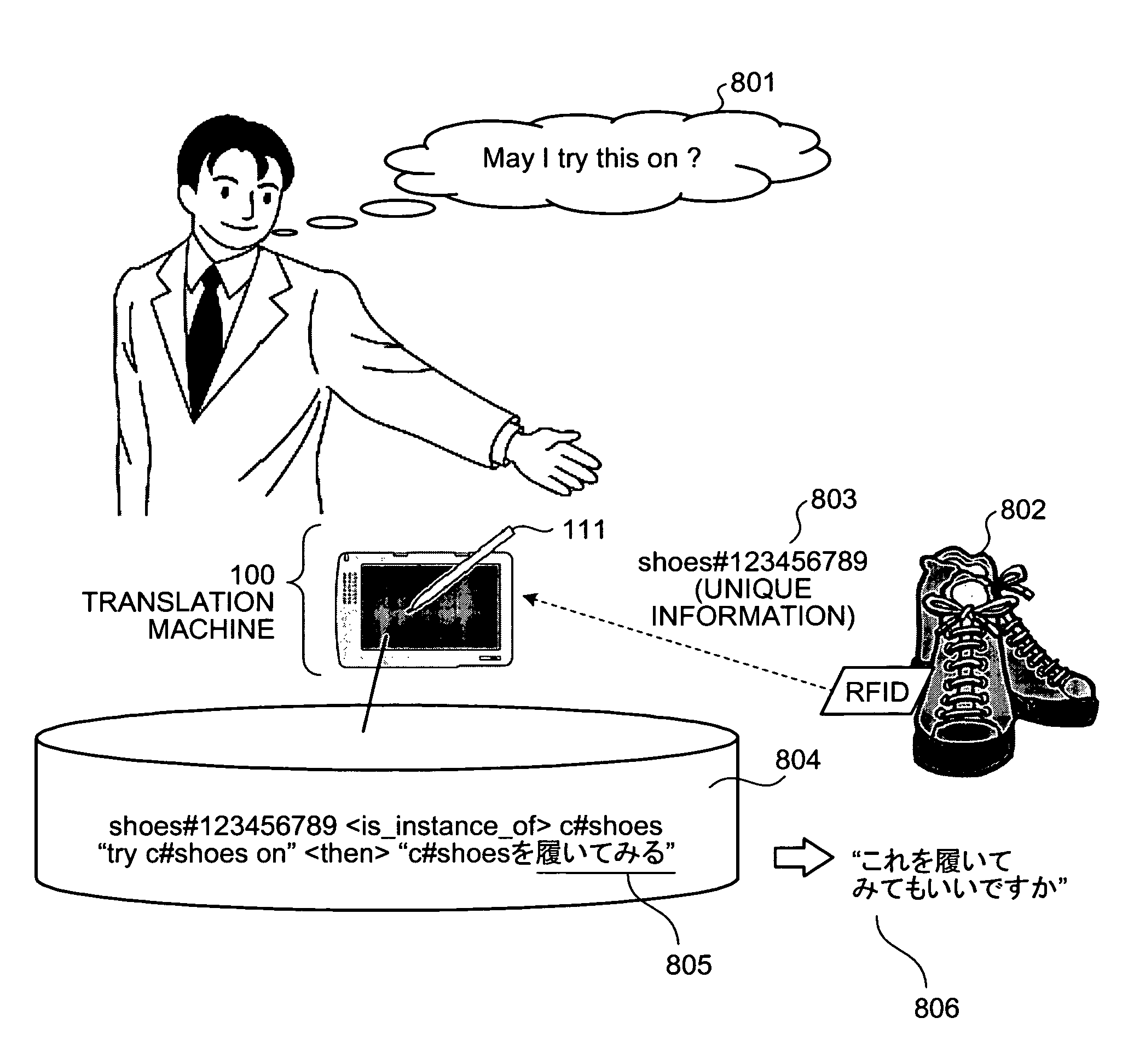Apparatus, method and computer program product for optimum translation based on semantic relation between words
a technology of machine translation and semantic relation, applied in the field of machine translation apparatus, machine translation method and computer program product for optimum translation based on semantic relation between words, can solve the problems of many problems that cannot be overcome for practical application, frequent use of deixis in spoken language, and limited application range of machine translation
- Summary
- Abstract
- Description
- Claims
- Application Information
AI Technical Summary
Benefits of technology
Problems solved by technology
Method used
Image
Examples
first embodiment
In a machine translation apparatus the information on an object designated by the user as soon as he / she begins to speak is detected, and the referent of the deixis included in the speech is identified and translated.
FIG. 1 is a block diagram showing a configuration of the machine translation apparatus 100 according to the first embodiment. As shown in FIG. 1, the machine translation apparatus 100 includes a identification information detection unit 111, a deixis pattern storage unit 121, a semantic class information storage unit 122, a semantic class hierarchy storage unit 123, a rule storage unit 124, an input receiving unit 101, a word dividing unit 102, a deixis detection unit 103, a referent identification unit 104, a semantic class determining unit 105, a translation unit 106 and an output control unit 107.
The identification information detection unit 111 is for reading the information on an object from a no-contact IC tag buried in the object such as a radio frequency identi...
second embodiment
In a machine translation apparatus the semantic class of a designated object detected is acquired from an external server connected to a network and used for translation.
FIG. 10 is a block diagram showing a configuration of the machine translation apparatus 1000 according to the second embodiment. As shown in FIG. 10, the machine translation apparatus 1000 includes a identification information detection unit 111, a communication unit 1012, a deixis pattern storage unit 121, a semantic class hierarchy storage unit 123, a rule storage unit 124, an input receiving unit 101, a word dividing unit 102, a deixis detection unit 103, a referent identification unit 104, a semantic class determining unit 1005, a translation unit 106, and an output control unit 107.
The second embodiment is different from the first embodiment in that the communication unit 1012 is added, the semantic class information storage unit 122 is eliminated, and the function of the semantic class determining unit 1005 i...
third embodiment
A machine translation apparatus determines whether the distance to a designated object detected is included in the distance range indicated by a deixis contained in the input speech, and when it is so included, a referent of the deixis is identified.
FIG. 12 is a block diagram showing a configuration of the machine translation apparatus 1200 according to the third embodiment. As shown in FIG. 12, the machine translation apparatus 1200 includes a identification information detection unit 1211, a deixis pattern storage unit 121, a semantic class hierarchy storage unit 123, a rule storage unit 124, a distance attribute storage unit 1225, an input receiving unit 101, a word dividing unit 102, a deixis detection unit 103, a referent identification unit 1204, a semantic class determining unit 1205, a translation unit 106, and an output control unit 107.
The third embodiment is different from the first embodiment in that the distance attribute storage unit 1225 is added, the semantic class ...
PUM
 Login to View More
Login to View More Abstract
Description
Claims
Application Information
 Login to View More
Login to View More - R&D
- Intellectual Property
- Life Sciences
- Materials
- Tech Scout
- Unparalleled Data Quality
- Higher Quality Content
- 60% Fewer Hallucinations
Browse by: Latest US Patents, China's latest patents, Technical Efficacy Thesaurus, Application Domain, Technology Topic, Popular Technical Reports.
© 2025 PatSnap. All rights reserved.Legal|Privacy policy|Modern Slavery Act Transparency Statement|Sitemap|About US| Contact US: help@patsnap.com



